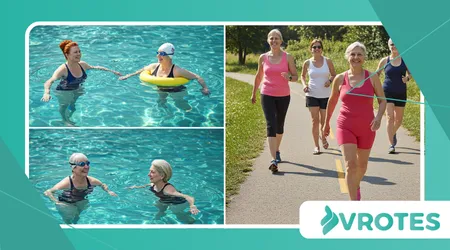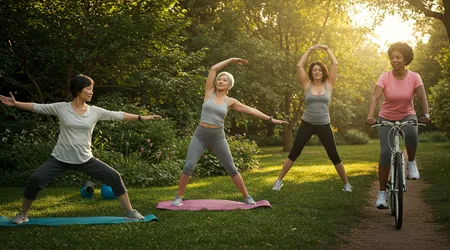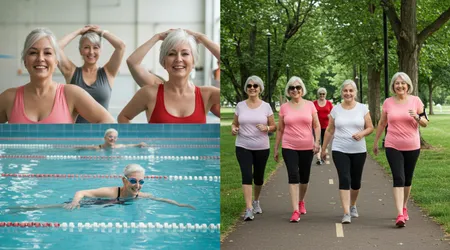Low-Impact Cardio Workouts to Boost Heart Health After 50

Low-impact cardio workouts are a game-changer for midlife fitness, especially for those over 50 seeking to strengthen their heart without straining their body.
As we age, prioritizing heart health becomes non-negotiable cardiovascular disease remains a leading cause of mortality globally, claiming roughly 17.9 million lives annually, according to the World Health Organization.
Yet, the fear of injury or overexertion often deters people from staying active. The good news? You don’t need to sprint or leap to keep your heart strong.
Gentle, sustainable exercises can deliver powerful results, enhancing cardiovascular fitness, mood, and longevity.
This article dives into why low-impact cardio workouts are ideal for midlife, offering practical examples, science-backed benefits, and creative ways to integrate them into your life. Ready to redefine fitness on your terms? Let’s explore how to move smarter, not harder.
The beauty of low-impact cardio workouts lies in their accessibility. They elevate your heart rate without the joint-jarring intensity of high-impact exercises like running.
For those navigating midlife changes think menopause, joint stiffness, or reduced recovery capacity these workouts are a lifeline.
They align with the American Heart Association’s recommendation of 150 minutes of moderate aerobic activity weekly, achievable through activities like brisk walking or swimming.
Why Heart Health Matters After 50
Aging brings changes that make heart health critical. Blood vessels stiffen, blood pressure can rise, and hormonal shifts increase cardiovascular risks.
Low-impact cardio workouts counteract these changes by improving circulation and reducing blood pressure.
A 2024 study in the European Heart Journal found that combining aerobic and resistance exercises reduces cardiovascular risks by up to 20% in overweight adults.
These workouts also enhance insulin sensitivity, crucial for managing diabetes risk. Unlike high-impact routines, they minimize joint stress, making them sustainable for lifelong fitness.
Gentle cardio strengthens the heart muscle, boosting its efficiency. It also lowers LDL cholesterol and supports weight management. For midlife women, low-impact cardio workouts can ease menopause-related symptoms like fatigue.
They promote mental clarity, reducing stress and anxiety. By prioritizing movement over intensity, you protect your joints while reaping cardiovascular rewards. Consistency matters more than intensity regular activity sustains these benefits over time.
++ Top 7 Calcium-Rich Foods to Protect Bone Health in Menopause
Why choose low-impact over high-impact? High-impact exercises like jumping jacks can strain aging joints, increasing injury risks.
Low-impact cardio workouts offer similar heart benefits with less wear and tear. They’re ideal for beginners or those with conditions like osteoporosis.
The focus is on steady, rhythmic movements that engage large muscle groups. This approach ensures long-term adherence, fostering a healthier heart without burnout.

Top Low-Impact Cardio Workouts for Midlife
Brisk Walking: The Ultimate Accessible Exercise
Brisk walking is a cornerstone of low-impact cardio workouts, requiring no equipment beyond good shoes. Aim for a pace where talking is possible but challenging.
Walk in nature for added mental health benefits. Vary routes to keep it engaging parks, beaches, or urban trails work well. Start with 20-minute sessions, gradually increasing to 30–40 minutes.
Mix up your walks with interval bursts speed up for 30 seconds, then slow down. This mimics high-intensity interval training without joint stress.
Use a fitness tracker to monitor heart rate, aiming for 50–70% of your maximum. Walking with friends builds community, boosting motivation. Local walking groups are thriving in 2025, offering social fitness opportunities.
Also read: Integrating Acupuncture to Ease Hot Flashes Naturally
Try “zebra striping” walks alternate brisk and leisurely paces. This enhances fat-burning and cardiovascular efficiency.
Walking outdoors also exposes you to sunlight, aiding vitamin D production. For variety, explore virtual walking challenges online. Consistency transforms walking into a powerful heart-health tool.
Swimming: A Full-Body, Joint-Friendly Option
Swimming delivers a full-body workout, perfect for low-impact cardio workouts. The water supports your joints, reducing injury risks. Freestyle or breaststroke elevates heart rate gently.
Aim for 20–30-minute sessions, three times weekly. Local pools often offer adult swim classes in 2025.
Vary strokes to engage different muscle groups. For example, backstroke strengthens shoulders, while freestyle targets the core. Use a waterproof heart rate monitor for intensity tracking.
Swimming also cools the body, ideal for menopause-related hot flashes. Many facilities now provide aqua-aerobics for added fun.
Read more: How to Manage Night Sweats Without Disrupting Sleep
Incorporate swim intervals swim fast for one lap, then slow for two. This boosts cardiovascular endurance without overexertion. Community swim programs foster accountability.
Swimming’s meditative rhythm reduces stress, enhancing heart health. It’s a holistic midlife fitness solution.
Cycling: Fun and Functional Cardio
Cycling, whether stationary or outdoors, is a stellar low-impact cardio workout. It strengthens the heart and legs without knee strain. Aim for 30-minute rides at a moderate pace. Proper bike fit is crucial ensure slight knee bend at full extension. Cycling classes are booming in 2025.
Try interval cycling pedal hard for one minute, then coast. This mimics HIIT, boosting heart health. Use apps like Strava to track progress and join virtual challenges.
Outdoor cycling adds scenery, uplifting mood. Stationary bikes with digital classes offer convenience at home.
Group rides build camaraderie, making fitness social. Adjust resistance to match your fitness level. Cycling improves balance, reducing fall risks in midlife.
It’s also eco-friendly, aligning with 2025’s sustainability trends. Regular rides enhance cardiovascular resilience.
Tai Chi: Mindful Movement for Heart and Soul
Tai chi combines gentle movements with mindfulness, making it a unique low-impact cardio workout. It improves heart rate variability and reduces stress.
Practice for 20–30 minutes, focusing on slow, flowing motions. Online tai chi classes are widely available in 2025. Find a local group for connection.
The deliberate pace enhances balance, crucial for preventing falls. Tai chi also lowers blood pressure, supporting heart health.
Research shows it reduces cortisol levels, easing anxiety. Practice in a park for fresh air and calm. Tai chi’s meditative quality boosts emotional well-being.
Incorporate tai chi into your morning routine. Its low-impact nature suits joint-sensitive individuals.
Follow guided videos to master forms like “Wave Hands Like Clouds.” Community centers often host affordable classes. Tai chi fosters a heart-healthy lifestyle with grace.
Elliptical Training: Gym-Based Cardio Comfort
Elliptical machines offer smooth, joint-friendly low-impact cardio workouts. They mimic running without impact, ideal for midlife fitness.
Aim for 25-minute sessions, adjusting resistance. Most gyms in 2025 feature advanced ellipticals with digital tracking. Start with a comfortable pace.
Alternate forward and backward motions to engage different muscles. Use built-in programs for variety hill climbs or intervals.
Monitor heart rate to stay in the aerobic zone. Ellipticals support weight management, reducing heart strain. Home models are now budget-friendly.
Pair elliptical sessions with light strength training for balance. Listen to music or podcasts to stay motivated. Adjust stride length for comfort. Elliptical workouts burn calories efficiently, supporting heart health. They’re perfect for busy midlife schedules.
Integrating Low-Impact Cardio into Your Routine
Crafting a sustainable fitness routine is key after 50. Start with two 30-minute low-impact cardio workouts weekly, gradually increasing frequency.
Mix activities to avoid monotony walk one day, swim another. Schedule workouts like appointments to stay consistent. Track progress with a fitness app.
Listen to your body to avoid overexertion. Pair cardio with strength training for optimal heart health.
A 2024 study highlights combined routines reduce cardiovascular risks. Use wearable tech to monitor sleep and recovery. Small, consistent steps lead to lasting heart benefits.
Create a weekly plan, like this sample:
| Day | Activity | Duration |
|---|---|---|
| Monday | Brisk Walking | 30 minutes |
| Wednesday | Swimming | 25 minutes |
| Friday | Cycling | 30 minutes |
| Sunday | Tai Chi | 20 minutes |
Adjust based on energy levels. Rest days are crucial for recovery. Involve family or friends for accountability. Low-impact cardio workouts make fitness approachable and sustainable.
The Role of Technology in 2025
Fitness technology in 2025 enhances low-impact cardio workouts. Wearable devices track heart rate, steps, and sleep, personalizing your routine.
Apps like Fitbit offer guided walking or cycling sessions. Smartwatches now monitor stress, suggesting low-impact activities on tough days. Technology makes fitness data-driven and fun.
Virtual classes, from tai chi to aqua-aerobics, are booming. They provide structure and community from home. Use apps to set goals and track progress.
Technology also supports recovery monitor sleep to optimize workout timing. Embrace these tools to enhance heart health.
AI-driven fitness plans tailor workouts to your needs. For example, an app might suggest a 20-minute walk based on your heart rate data.
Online communities offer motivation through challenges. Technology bridges the gap between effort and results. Stay connected to stay committed.
Overcoming Common Barriers

Time constraints often derail fitness goals. Short, 20-minute low-impact cardio workouts fit busy schedules. Walk during lunch breaks or cycle while watching TV.
Lack of motivation? Join a local class for accountability. In 2025, virtual fitness communities thrive, offering support.
Joint pain can discourage movement. Swimming or tai chi minimizes strain while boosting heart health. Can’t afford a gym?
Walking and online tai chi classes are free or low-cost. Address barriers with creative solutions. Consistency trumps perfection in midlife fitness.
Fear of injury fades with proper form. Consult a trainer to learn safe techniques. Start slowly, building confidence. Lack of energy?
Low-impact workouts require less exertion. Partner with a friend for encouragement. Overcoming obstacles ensures long-term heart health success.
A Heart-Healthy Analogy: The Steady River
Think of your heart as a river, steadily flowing to nourish your body. Low-impact cardio workouts keep the current strong without flooding the banks.
High-impact exercises might stir turbulent waves, risking damage. Gentle, consistent movement ensures a healthy, resilient flow for years.
Practical Examples to Get Started
Example 1: The Morning Walk Ritual
Start your day with a 25-minute brisk walk around your neighborhood. Use a playlist to set the pace songs with 120–130 BPM work well.
Track your heart rate with a smartwatch, aiming for 60% of your maximum. End with gentle stretches to cool down.
Example 2: Poolside Cardio Fun
Join a local aqua-aerobics class for a 30-minute session. Alternate between water jogging and arm circles. The water’s resistance boosts heart rate without stress.
Finish with a relaxing float to unwind. Check community centers for affordable classes.
Frequently Asked Questions
What makes low-impact cardio workouts better for those over 50?
They reduce joint stress while improving heart health, ideal for aging bodies. Activities like walking or swimming are sustainable and effective.
How often should I do low-impact cardio workouts?
Aim for 150 minutes of moderate aerobic activity weekly, spread across 3–5 sessions. Mix activities like cycling and tai chi for variety.
Can low-impact cardio help with menopause symptoms?
Yes, it reduces fatigue, stress, and hot flashes by improving circulation and mood. Swimming and tai chi are particularly effective.
Do I need equipment for low-impact cardio?
No, walking and tai chi require minimal gear. Cycling or ellipticals are optional. Affordable apps and wearables enhance the experience.
How do I stay motivated?
Join a fitness group, track progress with apps, or pair workouts with music. Set small, achievable goals to build long-term habits.
By embracing low-impact cardio workouts, you’re investing in a stronger, healthier heart. Isn’t it time to move with purpose and protect your vitality?
Start small, stay consistent, and let your heart thrive.
